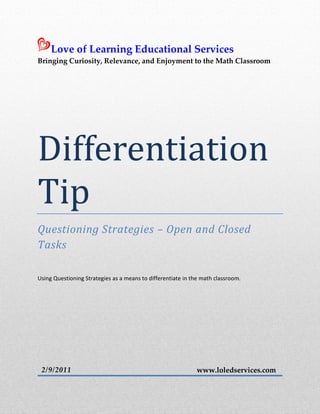
Differentiation tip questioning strategies
- 1. Love of Learning Educational Services Bringing Curiosity, Relevance, and Enjoyment to the Math Classroom Differentiation Tip Questioning Strategies – Open and Closed Tasks Using Questioning Strategies as a means to differentiate in the math classroom. 2/9/2011 www.loledservices.com
- 2. Differentiation Tip: Questioning Strategies Varying your questioning and targeting specific questions to specific students is a great way to differentiate instruction. During the course of a class, you can ask higher level or more open questions to students are at a higher level of readiness. You can direct lower level or more closed questions to students who have a lower level of readiness for the skill or concept being taught. If you're doing a lesson that involves manipulatives or problem solving, you can provide more or less scaffolding depending on the needs of the student. Many times opening (providing few parameters) or closing tasks (providing more parameters) can be an easy way to differentiate. Example of Differentiating by Opening or Closing a Task: Lesson: Exploring Fractions with Multilink Cubes Students are shown an example of a fraction tower made with multilink cubes. They are then given tasks to create their own fraction towers. This is a fraction tower that has one-half red cubes. Task A: Build a fraction tower that is made up of two-thirds red cubes. This task is completely open. The only parameter is that is must have two-thirds red cubes. Students have to decide how many total cubes to use. Some students might use 2 different colors and some students may use more than 2 colors to build their towers. Task B: Build a fraction tower with 9 total cubes and is made up of two-thirds red cubes. This task is now somewhat closed because you have stated how many total cubes to use for the tower. If students were having trouble with the Task A because it was too open, this would be one way to make it easier. It does still have an open element to it because you haven't stated if the tower has to have exactly 2 colors or more than 2 colors. ©2010 Love of Learning Educational Services, LLC. All rights reserved.
- 3. Task C: Using 3 different colors, build a tower that represents two-thirds. This task is mostly open with 2 parameters: 3 colors and represents two-thirds. Task D: Using 3 different colors and 6 total cubes, build a tower that represents two-thirds. This task is completely closed. Since you are using 6 total cubes and representing two- thirds, you would not be able to create a tower with more than 3 colors. If you had specified a value greater than 6 for the total cubes, there would still be an open element to the task. Task E: Build a tower that is one-half red, one-third green, and one-sixth blue. This task has 3 parameters, but is open in respect to the total number of cubes used to build the tower. If students were struggling with this task, it could be made easier by giving a total number of cubes or by scaling back on the given parameters. For example, you could just say to build a tower that represents one-sixth. Adjusting questions and tasks can be a quick and easy way to differentiate instruction, but it does take some practice. The great thing about this strategy for differentiation is that you have plenty opportunities to practice and fine tune it! Website’s Weekly Features: If you like this, see more Differentiation Tips for math teachers as part of the Weekly Features on our website. You’ll find the following topics as part of our Weekly Features: Math Manipulative of the Week Technology Tip Differentiation Tip Brain-Based Learning Teaching Strategy Featured Video Featured Blog Featured Book Check out our Weekly Features at: www.loledservices.com Read our Blog at: www.loledservices.blogspot.com ©2010 Love of Learning Educational Services, LLC. All rights reserved.
- 4. Contact Us: Kristi Grande kristi.grande@gmail.com ©2010 Love of Learning Educational Services, LLC. All rights reserved.
